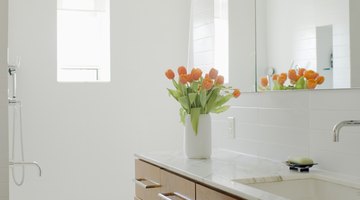What Causes Cultured Marble Sink Bowls to Crack?
Cultured marble, also known as man-made marble, is composed of crushed limestone and fiberglass resin. The strength and stain resistance of this material makes it a good choice for sink bowls.

However, despite their durability, cultured marble sink bowls can crack under the right circumstances, and opinions vary on whether these cracks can be simply repaired or the sink must be replaced.
Temperature
Most cracks in marble sink bowls are known as “thermal shock” cracks and are the result of introducing extremely hot water into a cold sink basin. This can be hot water coming out of the faucet or heated water from a tea kettle, oven, microwave or some other source. LamTech, a cultured marble manufacturer, guarantees their sinks to 150 degrees Fahrenheit, but states that temperatures above this number will produce thermal shock and nullify the terms of the service contract.
Installation
Some consumers install their own cultured marble sinks and countertops and also drill holes in the marble for sink fixtures. Each time a hole is drilled or cut in the cultured marble, there is a chance that the marble can crack. MarCraft, Inc. recommends using a carbide-tipped saw to drill through the finished side. Drilling from the underside of the cultured marble may result in cracks and chips.
Repair vs. Replacement
Opinions vary on repairing versus replacing cultured marble sinks that have sustained cracks. According to LamTech, the cracks cannot be repaired. AskTheBuilder.com concurs, stating that minor nicks and scuffs can be fixed by someone who is certified to repair cultured marble, but warns that cracks in cultured marble sinks are almost impossible to restore.
Repair Process
However, some companies sell do-it-yourself repair kits for cultured marble sinks. One company details a process that involves sanding the crack using sandpaper, applying filler, and then matching and applying base paint. The kit, which averages $30, includes several sheets of sandpaper in varying grits, filler and a spatula, base paint and tint, a spray bottle, and a container of cream hardener.
References
Writer Bio
Terri Williams began writing professionally in 1997, serving as media manager for a large nonprofit organization where she also edited books and created promotional content. She has written extensively on business communication, ethics, leadership, management, education and health. Williams has a Bachelor of Arts in English from the University of Alabama at Birmingham.
Photo Credits
- Jupiterimages/Creatas/Getty Images
- Jupiterimages/Creatas/Getty Images
More Articles



